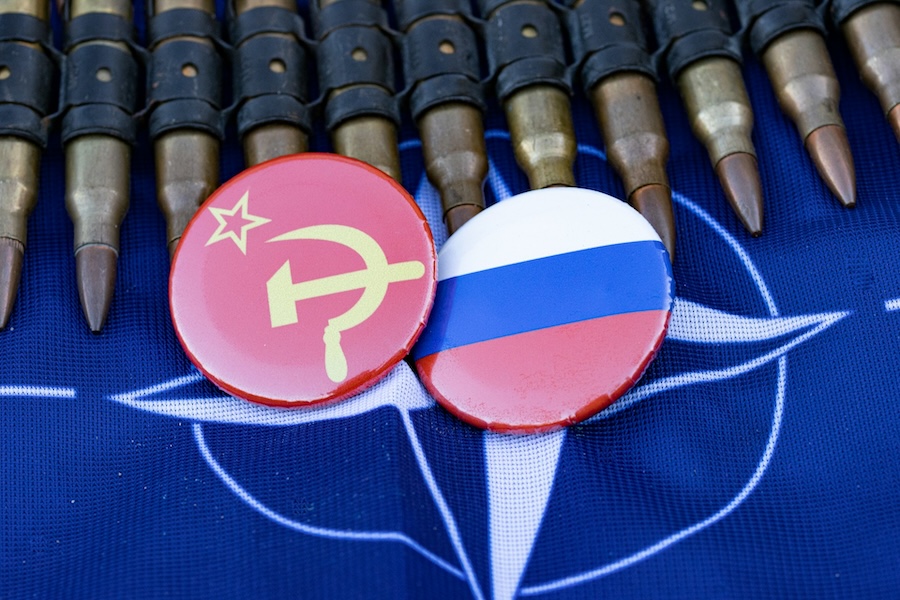Part 1: Within the Country
Dmitry Dubrovsky
Photo: At least a third of the research budget currently goes to developments directly related to war. Photo by Marek Studzinski on Unsplash
“Wild Putinism”
The routinization of the war and murky forecast for changes in the political situation in Russia influence the strategies of both scientists who have remained in the country and those who have left. These strategies, in turn, shape possible scenarios for the development of Russian science both within the country and abroad.
Within Russia. It is entirely likely that the level of political pressure on universities and the Russian sciences in general will not decrease, even after the military hostilities end. The regime has clearly entered a new phase of transformation—what Tatiana Stanovaya from the Carnegie Center calls “Wild Putinism.” This phase is characterized by the absence of a systemic policy within the country and the unpredictable course of politics.
Abroad. Outside of Russia, especially in Europe, where the “philosopher’s fleet” is headed, a variety of initiatives are emerging that aim to reduce the number of Russian citizens in response to “security challenges.” The new U.S. administration is demonstrating an increasingly isolationist policy. For those Russian scientists who do not see living and working in modern Russia as a possibility, the problem of finding strategies for survival and personal development is becoming increasingly acute.
Today, we are talking about those who have remained in Russia.
The Re-Sovietization of the Russian Sciences
Once again in the history of Russia, scientific disciplines are undergoing various transformations.
STEMM
For most representatives of STEMM (science, technology, engineering, mathematics and medicine), the current crisis doesn’t just limit opportunities for international research. The sharp increase in war funding has significantly reduced the funding for research programs.
According to the UNESCO Institute for Statistics, the real figures for R&D support in 2022 amounted to only 0.94% of GPD (for comparison, in the US this figure is 3.46%, while Israel, the world leader, is at 5.56%). It is important to note that in absolute terms, the difference is much more significant—in the US it is about US$600 billion, while in Russia, it is about US$20 billion.
By the most conservative estimates, the cost of military operations in Ukraine is no less than US$40 billion per year.
In addition, the introduction of sanctions in Europe and the US has directly affected both numerous research projects and the availability, quality, and cost of equipment and consumables for applied research. Obtaining exact data on this is difficult. It is evident that if before the war, about 15-20% of R&D went to military needs, then during the war this amount has increased significantly. It can be assumed that at least a third of the research budget is currently spent on developments directly related to war.
Obviously, this not only creates pressure on scientific research in the form of various kinds of securitization—including a noticeable increase in “espionage cases” in areas where research intended for military purposes is conducted. It also creates a significant bias toward defense-oriented research.
The funding structure for STEMM is increasingly reminiscent of the situation during the Soviet Union:
- The lion’s share of funding goes to applied military research.
- State security control over research is growing significantly.
At the same time, the number of scientific staff is falling to a record low for the Russian Federation. This is partly explained by both the aging population within the Russian sciences and the insufficient number of young people to replace those who retire, as well as the departure of scientists from the country.
The humanitites and social sciences
Compared to STEMM, the humanities and social sciences have never required as much funding. Support for such research has always been quite modest.
For example, on the list of fundamental research projects supported by the Russian Science Foundation in 2024, only 639 of 3,263 projects were related to the humanities and social sciences. Obviously, the scale of support is also completely different. According to general estimates, up to 15 percent of R&D is used to finance research in the humanities and social sciences, while the rest goes to STEMM.
New geography, new topics. An analysis of projects supported by the Russian Science Foundation shows noticeable ideological influences. Among projects given funding, many are from the “new” (that is, occupied) Russian regions, as well as those focusing on the development of a “new political course” that includes a “turn toward the East.”
Thus, within the framework of the competition for humanitarian and social knowledge, the following projects were funded:
- “Representation of Russia as a Civilization-State: The Case of New Regions (Risks and Technologies for Overcoming Internal and External Challenges)” (Sevastopol)
- “Tax and Budget Regulation of Post-Conflict Reconstruction of the New Region of the Russian Federation” (DPR)
- “Interests and Development Policy of the Territories of China and the DPRK Adjacent to Russia (Primorsky Krai)”
- “Monuments to the Events of the Great Patriotic War on the Territory of the Republic of Crimea (Crimea)”
However, there are quite a few overtly ideological projects in general, and it is obvious that they do not set the tone in Russian research in the field of humanitarian and social sciences. Rather, we are talking about targeted support for a small number of topics of interest to the Russian regime and some organizations that represent the “new regions.”
Ideology. At the same time, it is obvious that the authors of projects mimic ideological goals in order to obtain funding, generally trying to preserve one or another existing tradition or scientific direction.
It is no less obvious that, just as in the Soviet era, many disciplines of the Russian humanities and social sciences have become ideologically charged. The following have suffered seriously:
- international law
- human rights
- public sociology
- gender studies
- history, especially the history of the 20th century and World War II
- political science, especially the study of modern Russia as an autocratic regime
All of this creates significant pressure for researchers working in this field to consider changing their research topics, leaving the profession, or moving away.
Risks. In this sense, teachers in the humanities and social sciences have it worse. They have significantly fewer options. This includes, for example, abandoning courses that they taught previously if these courses now require serious ideological content or even consist entirely thereof. The introduction of such courses—in particular, the Fundamentals of Russian Statehood—requires ideological loyalty from the teacher instead of pedagogical skills.
However, the actual practice of teaching such courses is far from the stated goal: promoting political loyalty to the Putin regime and the war of aggression. Clearly, this goal has not been achieved. But it is no easier for those who work and study at universities in the “special operation” era. They are under pressure and suspicion. And therefore, simply expressing a critical attitude to a deliberately ideological product can cost them their job, their position at the university, or even expose them to administrative or criminal prosecution by the state.
Survival strategies. As a result, there are few options for teachers in the humanities and social sciences:
- don’t teach these courses; do something “apolitical”
- distance yourself as much as possible from any research topics that could be a source of trouble
This kind of escapism was well mastered by Soviet practitioners of the humanities, who found protection from ideological control in studies of antiquity, theoretical research, and subjects far removed from the ideological interests of the Soviet system.
Scenarios for the Development of Science and Higher Education within Russia
Based on the listed factors and the most obvious strategies, it can be assumed that with the current course of politics, Russian science and higher education have three possible scenarios for further development. These scenarios are not mutually exclusive. Depending on the specifics of a particular sector of science or higher education and the combination of ideological pressure and control of the Russian regime, one or more of the different scenarios listed below will come to fruition.
Scenario 1: Re-Sovietization. In this scenario, universities and research institutes become increasingly integrated into the state ideological system, losing their independence—in Soviet style—but at the same time maintaining a conditional “internal freedom” and expanding the “silent resistance.”
It is evident that total control in the Soviet vein is currently both unattainable and unnecessary for the Russian political regime—just as it was not needed in the 1960s and 1970s in Soviet science and higher education.
Scenario 2: Voluntary Adaptation and Correction. Some institutions, especially academic institutions, may try to preserve academic freedom through increased self-censorship or guarantees of loyalty through patrons in power. Having limited autonomy and financial support from patrons will allow them to remain competitive in conditions of isolation from the international community.
One possible model could be various types of cooperation with universities in BRICS countries. Such a model would most likely be possible for STEM research institutes and would be unlikely to be in demand for the humanities and social sciences.
Scenario 3: The Chinese Model. All academic science will try to switch, provisionally, to the “Chinese scenario,” implementing an alternative model of scientific production. This is a possible scenario for a large number of state-controlled educational institutions. The generational change may lead to the emergence of a new “scientific contract” following the Chinese model: the so-called “social responsibility” of the teacher or researcher. From the point of view of the traditional notion of academic freedom, this means a rejection of criticism of the state and the recognition of certain areas of the humanities and social sciences as spheres not of scientific knowledge, but of ideological interest.
However, such a scenario will require significant effort and time to completely change the perception of teachers and students themselves about the essence and meaning of scientific and teaching work.
In the next article, we will talk about the strategies of Russian scientists who have left the country.





0 Comments